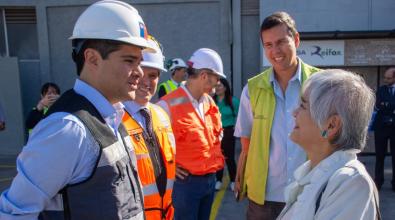5 questions for Geoff Mulgan on 'whole of government' innovation

What does it take to get all of a government’s agencies and actors working together to take on big challenges? That’s something Geoff Mulgan is thinking a lot about lately.
As part of his duties chairing a European Commission learning program, Mulgan recently published a report on whole-of-government innovation. While the work is focused largely on national-level governments, Mulgan says the lessons ring true in city halls as well.
“From cities to national governments, they all have these functional vertical silos in the form of departments of transport or housing or education,” Mulgan tells Bloomberg Cities. “And it’s been an issue for as long as anyone can remember, that real problems—and the needs of a community—cut across those boundaries. This question of how do you get the right balance of the vertical and the horizontal is a universal one, and every city administration faces it.”
Mulgan is a Professor of Collective Intelligence, Public Policy, and Social Innovation at University College London, and previously led Nesta, the U.K.’s innovation foundation. He’s also the author of a number of books, including most recently “Another World is Possible,” which calls on leaders from all sectors to recharge their abilities to imagine a better future.
We caught up with Mulgan to learn more about whole-of-government approaches to innovation and how city leaders can deploy them. (Read his whole report here.)
What are some examples of whole-of-government innovation in practice?
The U.S. federal government during World War II is an extraordinary story. Under [President Franklin Roosevelt], starting before the U.S. joined the war, a new set of people were brought in to dramatically transform the U.S.’ capacity—not only to produce planes, tanks, and ships, but also to innovate dramatically fast in everything from what became the atom bomb, to radar, to rocketry, etc. And it required a flexibility in relation to structures, which is extraordinary in retrospect. The quantities that were being manufactured by the end of the war are mind boggling. If you ever wanted to see government in action, that was it.
But there are also good peacetime examples. One that is very relevant to where we are now is what happened after the oil-price shock of the 1970s, when Japan—working closely with its cities and its regions—realized that, as an oil-importing nation, they were really threatened by a dramatic shift in oil prices. There was a hugely concerted effort to cut energy use and to dramatically improve energy efficiency. It was, in a way, led from the top. But it required a lot of coordination with business, with the engineers, with the technologists. And it was incredibly successful in not only dramatically cutting [Japan’s] energy use, but also achieving a jump in productivity and efficiency, which helped them have another 20 years of success in the world economy. Given where we are in energy now, it's quite an interesting example of how to adapt to a shock in a way that actually leaves you better off than before.
Are whole-of-government innovations only actionable when we’re faced with some kind of existential threat?
It's always easier to change things if you are facing an existential threat. But the definition of “leadership” is the ability to use the smallest crisis for the biggest effect—not to wait for the truly existential crisis, but to generate a sense of need for transformation within your system ahead of the crisis. That's what the best leaders do. They are willing to reshape the structures to fit the current tasks—not the priorities of 10 or 20 years ago—and to inject a sense of urgency and agility into their staff and stakeholders.
It’s also important to communicate a sense that problems can be solved, that you are not a passive respondent to big challenges. I've always opposed using the language of "wicked" problems, as if there are some problems that are inherently insoluble. When I was in the U.K. government, we worked on homelessness, and that had been seen as a wicked problem. But it was a classic example where, if you could orchestrate everything—from your support for people on the streets to mental health services, alcohol, drug services, how people were being discharged from prisons or the army—you could actually pretty much eliminate the problem. We cut it by 80 to 90 percent across the country in the main cities, through a very strategic, holistic, whole-of-government approach.
What are some of the tools of whole-of-government innovation?
One is budgets. In any bureaucracy, it's good to have some of your budget allocated to cross-cutting priorities, not just to your vertical departments. On the homelessness example, we pooled the budgets of housing, health, and other services so that they were only focused on tackling homelessness. It was still a smallish proportion of the total budgets, but it meant there was a group of people who could operate in a much more flexible way deploying money.
Similarly, create teams. They can be temporary teams, ideally brought in from different departments, but who, for maybe a year or 18 months, are really focused on problem solving in a cross-cutting way, rather than just delivering a service or running things in a business-as-usual way.
There’s a need to reorganize knowledge and data. If a city has a flotilla of different agencies working on a topic, it’s critical to ensure that someone is actually curating and sharing the knowledge about what's being done, what's working, what's being learned. Usually, we waste all of that knowledge, as it's fragmented in different fields. Sharing the data is also critical. One issue I work on now is “net-zero” and decarbonization. In most cities, the crucial data, like the energy use of households or transport data, are owned by different companies. It's not pooled, it's not shared, it’s not orchestrated. Integration of data and knowledge will increasingly be seen as the pre-condition of effective citywide problem solving.
And finally, we need a new way of organizing place-based partnerships. Almost every big challenge now has to be a partnership of the city, business, civil society, universities, communities, and so on. The more we can move to more systematic ways of bringing those stakeholders together—ideally, with each committing to what they're going to do, having some shared and mutual accountability for their actions, and mutual support—the better.
One thing I discourage governments from focusing too much on is committees. The easy thing for a government to do is to create a committee of the different departments—and then hope it will solve the problem. And it usually doesn't do any harm. But again and again, you find it doesn't really have enough traction. What’s needed is to change the wiring of the system or the city, which is about the allocation of money, the allocation of authority, the priority setting.
Is whole-of-government innovation mostly something nation-states do, or can it work at the local scale?
My first job was in a city administration. I've always thought their virtue is that they are less prone to the kind of rhetorical flourishes you get in national government, which is often grand plans that are quietly forgotten three years later. Whereas in a city, it has to be concrete.
The most interesting topics are ones where there is a big, maybe global, challenge that becomes very practical in a city. With getting to net-zero—in a city, that is all about the details of how you retrofit homes, how you shift their energy sources, how you cut the waste of your own buildings and fleet, how you move to electric cars. There are 101 different things, but they're all very tangible. In many ways, cities are much more where the action is happening on the big challenges.
What’s your biggest hope for where the public-sector innovation movement is headed?
There have been past eras when the world was changing very fast, needs were changing very fast, and governments struggled to catch up. We are in one of those moments again, with a phenomenal speed of change in technology, in jobs, and in our environment.
My hope is that the public-sector movement will be emboldened by the pandemic, when governments around the world did respond incredibly fast—and people overall, for all the pain, suffered much less than they might have in an equivalent set of crises 100 years ago. I hope they're encouraged by that, and I hope they retool themselves to realize what a big role they have in keeping people healthy, happy, and thriving—and then apply that not only to the fast crisis of the pandemic, but also the slower crises of things like climate change, inequality, and aging.
That’s what we’ve got to do this decade, rather than revert to the lack of confidence we saw in the U.S., the U.K., and other countries for many years, where everyone thought the market would solve everything. As soon as a financial crisis hits or a pandemic hits, you realize that's not true.



